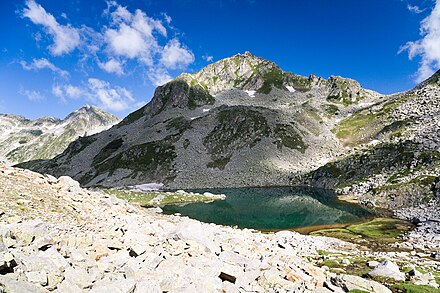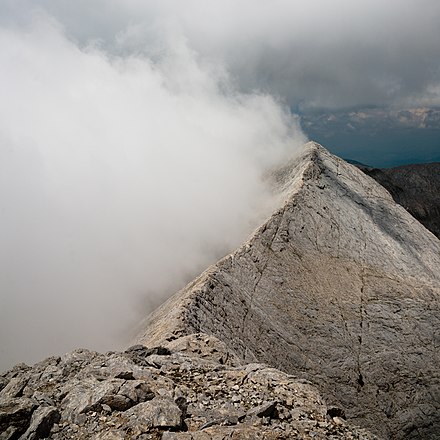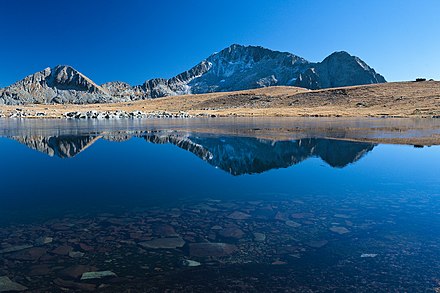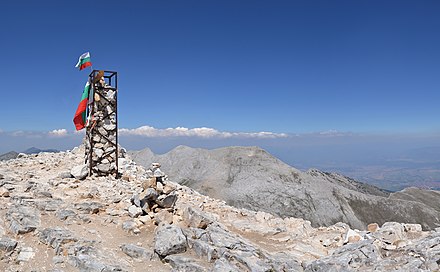Pirin is in Pirin Macedonia, in Bulgaria. The range is a national park and since 1983 part of the UNESCO World nature heritage.

Get in
Bankso
Bansko, the popular ski resort, is an important entry gate for the Pirin range.
- Several buses per day go from Bansko bus station (from the bridge near the bus and train stations, also calls at Strazhite Hotel) to Vihren hut at 08:30, 13:20, 17:00, and return from Vihren hut at 09:30, 14:20 and 18:00. 8 лв.
- The taxi is around 25 лв.
- In summer there is a once a day gondola 08:00 and 16:30.
- A good option to reach Pirin from Bansko is to hitchhike, which is particularly easy during the summer with a good amount of domestic tourists heading up to either of the huts. Walk south (gently uphill) from the train or bus stations though town until you reach the entrance to the Pirin National Park, indicated by a small house for information about the park. From there, the only cars going will be into the park.
Sandanski
Another popular entry point is via Sandanski, about which this article is lacking.
Get around
Once inside you will have to hike, the different huts and summits are connected by hiking trails. There are many different options for hikes, with indications on how many hours each hike will take at a moderate, comfortable pace. If you plan to spend a while hiking, check with the tourist office (during normal business hours) to get a map of the area and plan out your hike.
For reliable offline maps, including trails and huts, consult OpenStreetMap, which is used by this travel guide and by many mobile Apps like OsmAnd or Mapy.cz. Or just download the according GPX or KML files through Waymarked Trails for such trails on OpenStreetMap. (Note, you just need to change the OpenStreetMap relation ID to download the GPX or KML files through the same link.)
See
There is a broad network of flagged trails through the mountains. The Pirin tourist map (1:50,000, available at local shops) offers a good overview of the trails and huts/chalets to sleep in.
Notable geological features of the park include:
- Vihren (Mt Vihren). The second highest peak in Bulgaria and third on the Balkan Peninsula. Many do this as a day tour from Vihren hut, which can be reached by road, i.e. car and bus. 2021-12-09

- Koncheto, 41.7812557°, 23.3932232°. A name given to an approximately 200 m long ridge between the 2nd and 3rd highest mountains in the range with steep cliffs on either side, leading to an amazing panorama. 2021-12-09

- Tevno Ezero Lake, 41.69967°, 23.47991°. A very picturesque lake with a shelter/hut for overnighting. The hut is quite pricey and the owner not the most friendly person, but the surrounding is well worth the trip. If you do not want to stay here, heading out southeast, there are some wilderness huts and serviced huts after around 10 km. 2021-12-09
Do
Popular with domestic tourists, you can hike Mt. Vihren, the second highest peak in Bulgaria (2,914 m). Round trip from the Vihren hut takes 6 hr; it is a beautiful mountain which offers beautiful views.
There are also plenty more trails to be discovered. The area around Vihren peak is quite barren, so you may want to hike in lower elevations if you want to explore more of the incredible pine forests in the area.
Eat
Most serviced huts offer basic meals, provided you can communicate with the caretaker. Prices are low, and food in generally tasty. For example, a good breakfast will cost around 6 лв, a dinner with beer will be around 10–12 лв, a soup 3–4 лв, omelette 6 лв, and a hearty salad will be 5–7 лв. Coffee and tea are 1–2 лв.
Sleep
There is a network of mountain huts/chalets, which offer rooms and bungalows (bungalow for about 20 лв for two persons). Bring your sleeping bag just in case, but you can expect that a dorm room in the hut will provide blankets and sometimes even clean linen, the latter becomes more sparse the more remote.
Sleeping in the huts is 15-20 лв. Prices are often pinned at the wall inside of the huts. BTS member pay a few leva less.
Alternatively, there are marked camping areas around the huts. There is a popular, inexpensive tent camping area around Banderitsa, close to the restaurant and water source, about 20-30 min walking slightly downhill from Vihren hut/chalet.
Many popular huts are serviced between April and November. But even if not serviced, the sleeping area is often left open during winter.
Stay safe
This is mountainous terrain between 2,000-3,000 m, which can be rough, slippery sometimes, with steep cliffs, and getting cold at night very quickly. Take the usual precautions.
If inexperienced, better just do Mt. Vihren and Vihren hut, or go with an organised tour.
Take well enough time to hike the trails, due to the sometimes rugged underground, walking speeds of 2-3 km/hr are not uncommon.
Except for the popular trails, most are badly marked and you will better have GPS and maps with you.
Go next
- Bansko – The skiing village to the slope of Mt. Vihren, very touristy.
- Melnik
- Rhodope Mountains – Not as steep as Pirin, and thus probably more enjoyable for people less used to alpine conditions.
- Sofia - If taking the train, you will want to check the schedule of departures. You will first have to transfer at Septemvri, so check the schedule to there.
